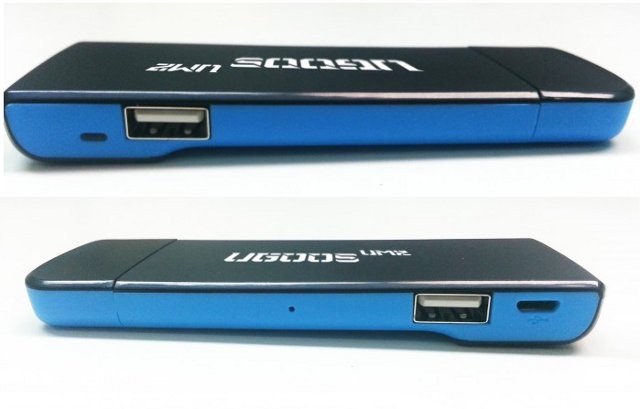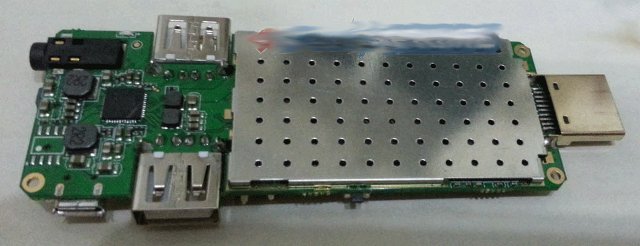Most Android HDMI TV dongles come with only one full size USB port, as well as some micro or mini USB ports. The user then has to use an external USB hub if he or she wants to connect standard USB keyboard and mouse, and ends up with some kind of cable mess. Ugoos UM2 mini PC does not have this issue as it comes with 2 full size USB ports.
The rest of the specifications are standard for a quad core HDMI TV Stick:
- SoC – Rockchip RK3188 Quad core Cortex-A9 + Mali 400 MP4 GPU
- System Memory – 2GB DDR3
- Storage – 8GB NAND Flash (Option for 16G/32G) + micro SD card slot (Up to 32GB)
- Connectivity – WiFi 802.11 b/g/n, Bluetooth (Version 4.0 TBC)
- Video Output – HDMI 1.3 Male
- USB – 2x USB Host ports + 1x micro USB port for power
- Power Supply – 5V/2A
- Dimension – 11x4x1.8cm
- Net Weight – 44 grams
This Android 4.2 device is said to come with a power adapter (5V/2A), an HDMI Cable, and optionally a 2.4GHz Wireless Air Mouse, a 2.4GHz Wireless mouse and keyboard, and/or a USB cable.
I could only find the device on Dealsprime for $69.99 for now (No HDMI cable, but it comes with power adapter and USB cable for power). They also have some unboxing and test videos if you are interested. You may also want to check Ugoos UM2 page for further (inaccurate) information.
Tip brought to you by Lucas.

Jean-Luc started CNX Software in 2010 as a part-time endeavor, before quitting his job as a software engineering manager, and starting to write daily news, and reviews full time later in 2011.
Support CNX Software! Donate via cryptocurrencies, become a Patron on Patreon, or purchase goods on Amazon or Aliexpress. We also use affiliate links in articles to earn commissions if you make a purchase after clicking on those links.






Got this sample one month ago, but pass it, i don’t know how many people will jump in because two usb port? the usb hub can solve all the problems? don’t know what this factory thinking? they should focus on improving their system performance, not just release this things.
@Eric
Two port sounds nice to have, but from your comment I sense that there are other issues.
Can you elaborate? Any advice on what would be a good buy for a mini pc (preferably with option to run Ubuntu as well)
@FransM
i have watched so many mini pcs, so i don’t have much feeling for this dual usb port mini pc, try it, and system is original android 4.2, the stock rom should still have the video skip problem, and i think the custom rom can fix it, but it need time. now the tronsmart t428, tronsmart mk908,imito qx1,neo x7 all have custom rom support to solve the video problem.
for Ubuntu, till now,i still recommend the Zealz GK802 which is base in freescale cpu, that one can run ubuntu well.
all rockchip base device can’t do ubuntu well now.
Eric obviously hasn’t even used or got a UM2. Video plays ultra smooth and it doesn’t have issues like the Tronsmart units. Even with the unstable unsafe custom ROMs that have been released for the Tronsmart series the video is not hardware decoding. The UM2 has hardware decoding, I have one on my test bench right now.
Kinda lame when people with agendas make up false stories about a product, just because they are so heavily invested in an old limp device, such as the Tronsmart.
As for the GK802 running Ubunto well, what an old wives tail, everyone who has tried it says it’s not really possible to use it for anything as it’s so slow and unstable.
UM2 is the new generation of Mini PC, and it mops the floor with the competition. Stable firmware, with hardware video decoding of 1080p high-bitrate media files. Including XBMC media center hardware decoding and DTS support.
@Eric
I have to disagree on RockChip + Linux (Ubuntu) comment, current RK3066 and RK3188 sticks actually run native Linux pretty nicely, sure I run Gentoo Linux, but there is no other platform that gives so much processing power for the price.
Only pick RK3188 sticks with Realtek WiFi, the rest of the chipsets suck . 🙂
Sure those Cortex-A15 Exynos boards might give even more processing power, but not at the same price range.
i.MX6 is not perfect either, it has all that nonsense with its GPU free driver, and it is wasting even more energy to get the same performance than RK family.
And how does hardware accelerated video decoding in Android have anything to do with how well the platform runs Linux? No hardware video acceleration exist in native Linux ARM world (Radeon UVD envy shining bright), sure you can hack the Android binaries to run within Linux, but that is not even close to how it should be done.
Is this native USB directly from RK3188 or an integrated hub? RK3188 has 3 USB interfaces: 1x OTG, 1x host and 1x HSIC host. A reasonable expectation would be that the second USB host runs through a HSIC transceiver, but could someone confirm?
BTW, could someone suggest any other RK3188 sticks that have two USB host interfaces + OTG?
they got the new little big octa development boards for $149 and the xu-e for $199
http://www.hardkernel.com/renewal_2011/products/prdt_info.php?g_code=G137510300620
i think it comes with a plastic cover i know its a dev board but whats stopping us using it as a media player or tv stick this one comes with the powervr gpu iam waiting for the next one and hoping that it will come with the new mali -t628 gpu
I love this site, but I’m getting pretty bored with Linux attempts on anything other than an RPi.
The fragmented approach to multiple socs and dozens of boards with variations make this a noble but isolated effort by some talented hobbyists.
What we need is a single reference design and for someone like rockchip to donate their 3066 dual core In its totality to either a nfp org or to set up one of their own. They have moved onto quad a9 and soon a15, so this should not be a problem.
Once this is in the hands of a dedicated nfp, they can work on hardware production. These are easily available at 35 to 50 now including cables and power supply.
Until you don’t have one single agenda and lots of brilliant minds working together android/Linux optimization on these devices will remain excellent skill honing tools for a small set of coders, but nothing more.
It’s beautiful and sad how a low spec device like the pi can achieve and teach so much just because of the operating structure in which it is managed
How come, that this UM2 would be the first and only RK3188-based Android mini-PC, where hardware video decoding supposedly works, when all the other ones have to resort to software decoding?
I very much doubt, that all the other mini-PC makers are incompetent, so what is the secret sauce making H/W decoding in the UM2 work, while Ugoos can’t even do it with their other RK3188 models?
@Eric
How did you get a sample one month ago when it just released?
@anon
I’d just like to say hardware video decode and encode works just fine with Freescale i.MX6 platforms in Ubuntu.
@Neezshun
Hardware platforms are being developed with RK3188 by Olimex and CubieTech, and they’ll probably used the leaked SDK to support the board. I guess they must have bought Rockchip SDK, but they may not be able to release it because of NDA, so that’s why the leaked one is “convenient”.
@tommy
Eric works with (owns?) GeekBuying, so he has direct contact with the factories, and he can try devices before they are released.
@Neezshun
Could not agree more.
The RK32xx is supposed to be an Cortex-A12 + Mali-T624 combo ref: http://www.cnx-software.com/2013/07/27/rockchip-socs-comparison-table-rk32xx-quad-core-cortex-a12-coming-up-in-2014/
Biggest downer for RockChip platform right now is the utter lack of proper kernel, the 3.0.36 just is way too dated, and full of silly bugs, that no sane person wants to tackle, they really need to update their base sources to the generic 3.4 or 3.10 codebases Google itself uses for Android 4.2/4.3.
@cnxsoft
I again have to disagree, the way all those Linaro/Ubuntu distros have accelerated video decode is by bundling the binary blob made for Android, and just compiling same version xorg/dri for it (dated xorg), not a FLOSS way, and you can do similar hack to RockChip Linux side too, so no added “openness” on i.MX6.
@other_anon
To me it looks like they have directly routed the two RK3188 ports to those USB hosts, the micro USB is nothing but plain 5V DC in.
That unfortunately also would mean that the used WiFi chipset is one of those connected to the never-the-same-config-among-mfgs GPIO/SDIO ports, thus there will be a driver incompatibility mess, that most of these ticks are plagued with.
@anon
Yes, sure it may not be fully open, but Freescale have support for their VPU via gstreamer, and an SDK is available. I can run Ubuntu 11.10 (and I think Ubuntu 12.04) and play videos with gstreamer. So with this platform, you can develop your own video (decode/encode) applications. I’m not quite sure it’s the Android blob. I haven’t checked the details, but I know it’s not using libhybris.
You can’t do any of that in Linux with Rockchip. AllWinner is a little better, but their libs are low quality, and not really usable in actual products.
@cnxsoft
OK, I stand corrected, the CODA960 is indeed supported via Linux kernel sources, nice indeed, and the sources for the libmfw_vpu are also available.
So you could build full support for i.MX6 VPU stuff from sources, a’la Radeon UVD.
But for RockChip you have to either wait (forever?) for them to open up the sources, or you can indeed do the Android blob hack with building the libstagefright (that is NOTHING but an generic API between software side and hardware, nothing hardware specific about it) that interface to the libvpu.so/libomxvpu.so/libomxvpu_dec.so Android blobs.
Exactly the same with Allwinner Android blob libvecore.so.
And there could be unified API if there would be an libstagefright that supported libmfw_vpu, nothing is against it, but for whatever reason it seems that Freescale devs intentionally want to steer clear from that… Not into video acceleration, so not sure why.
LOL @ Eric trolling the Ubuntu efforts on Rockchip – upset at the competition from the Cloudsto MK802III LE are we?
@cnxsoft
I’m inside of AsiaPads and did not have access to Ugoos UM2 1 month ago…